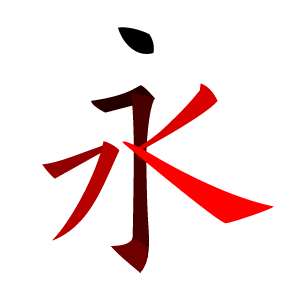Chinese character strokes
By contrast, the ancient seal script has line terminals within characters that are often unclear, making them non-trivial to count.identifying fundamental components of radicals, and implementing support for the writing system on computers.The terminals of the individual marks in ancient character forms are often unclear, and it is sometimes nontrivial to count them.Here are some examples: CJK strokes are an attempt to identify and classify all single-stroke components that can be used to write Han radicals.The character 永 (pinyin: yǒng) "eternity", described in more detail in § Eight Principles of Yong, demonstrates one of these compound strokes.An exception to this applies when a stroke makes a strictly right-angle turn in the Simplified Chinese names.Organization systems used to describe and differentiate strokes may include the use of roman letters, Chinese characters, numbers, or a combination of these devices.A naming convention is a classification scheme where a controlled vocabulary is used systematically to describe the characteristics of an item.The naming convention for a CJK stroke is derived from the path mark left by the writing instrument.Stroke count plays an important role in Chinese character sorting, teaching and computer information processing.[22] When the six plane strokes of “heng (横, ㇐), ti (提, ㇀), shu (竖, ㇑), pie (撇, ㇓), dian (点, ㇔), na (捺, ㇏)” are classified into four categories by putting "ti" into category heng, and na into dian, then together with the bent stroke category, a five-category system is formed:[24] Current national standards of PRC such as Stroke Orders of Commonly-used Standard Chinese Characters and many reference works published in China adopt the five categories of strokes, and stipulate the heng–shu–pie–dian–zhe (横竖撇点折) stroke-group order.[29] There are totally 30 strokes, sorted by the standard plane strokes order of heng (横; 橫, 一), tiao, ti (提; 挑, ㇀), shu (豎, 丨), pie (撇, 丿), dian (点; 點, 丶), na (捺, ㇏) and the bending points order of zhe (折), wan (弯; 彎) and gou (钩; 鉤).[citation needed] The stroke order follows a few simple rules, though, which aids in memorizing these.It plays an important role in the teaching, sorting and computer information processing of Chinese characters.This method is usually employed to support stroke-count sorting to deal with characters of the same stroke number.YES is a simplified stroke-based sorting method free of stroke counting and grouping, but without comprising accuracy.The strokes are summarized in the five categories of heng (横, 一 'horizontal'), shu (竖, 丨 'vertical'), pie (撇, 丿 'left-falling'), dian (点, 丶 'dot') and zhe (折, 𠃍 'bent').The data is from an experiment on the 16,339 traditional and simplified Chinese characters in the Cihai (1979 edition), sorted in descending order of frequencies of appearance.[20][16] The statistical results above made by different people on different character sets are basically consistent: The most commonly used stroke is heng (㇐), followed by shu (㇑).Stroke dian, including na (捺), appear more often at the end of characters or components.The Eight Principles of Yong explain how to write eight common strokes in regular script which are found all in one character, 永 (pinyin: yǒng, "forever", "permanence").It was traditionally believed that the frequent practice of these principles as a beginning calligrapher could ensure beauty in one's writing.



CJK Strokes (Unicode block)simplified Chinesetraditional ChinesepinyinChinese characterswriting materialwriting implementclerical scriptHan dynastyregular scriptTang dynastyEast Asian calligraphyseal scriptChinese character calligraphyradicalscalligraphy brushesHan radicalswriting instrumentink brushClassification schemestaxonomyCategorization schemesnominal numbernumbering schemecontrolled vocabularyUnicodeDictionaryRadical 1 一heavenly stemsRadical 5 乙Radical 2 丨Radical 6 亅Radical 4 丿Radical 47 巛Radical 3 丶Song typefaceright angleStroke numberstroke orderChart of Standard Forms of Common National CharactersEight Principles of YongCJK StrokesYES stroke alphabetical orderCJK charactersStroke-based sortingYES sortingXinhua ZidianXiandai Hanyu Cidianstrokescalligrapherbeautystroke count methodChinese character encodingChinese character description languagesChinese whole charactersIdeographic Rapporteur GroupWayback MachineQiu, XiguiCJK ideographsBlock nameHan unificationScripts contained in blockCJK Unified IdeographsCJK Unified Ideographs Extension ACJK Unified Ideographs Extension BCJK Unified Ideographs Extension CCJK Unified Ideographs Extension DCJK Unified Ideographs Extension ECJK Unified Ideographs Extension FCJK Unified Ideographs Extension GCJK Unified Ideographs Extension HCJK Unified Ideographs Extension ICJK Radicals SupplementKangxi RadicalsIdeographic Description CharactersCJK Symbols and PunctuationEnclosed CJK Letters and MonthsCJK CompatibilityCJK Compatibility IdeographsCJK Compatibility FormsEnclosed Ideographic SupplementCJK Compatibility Ideographs SupplementUnifiedHangulKatakanaHiragana